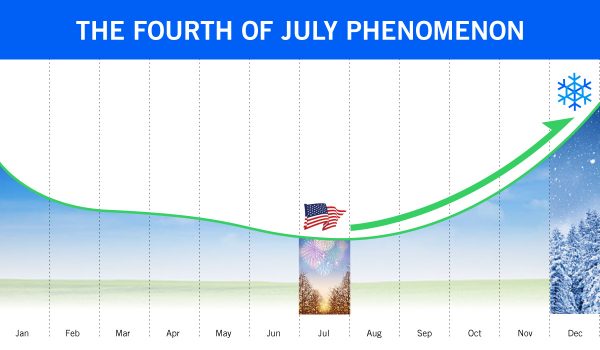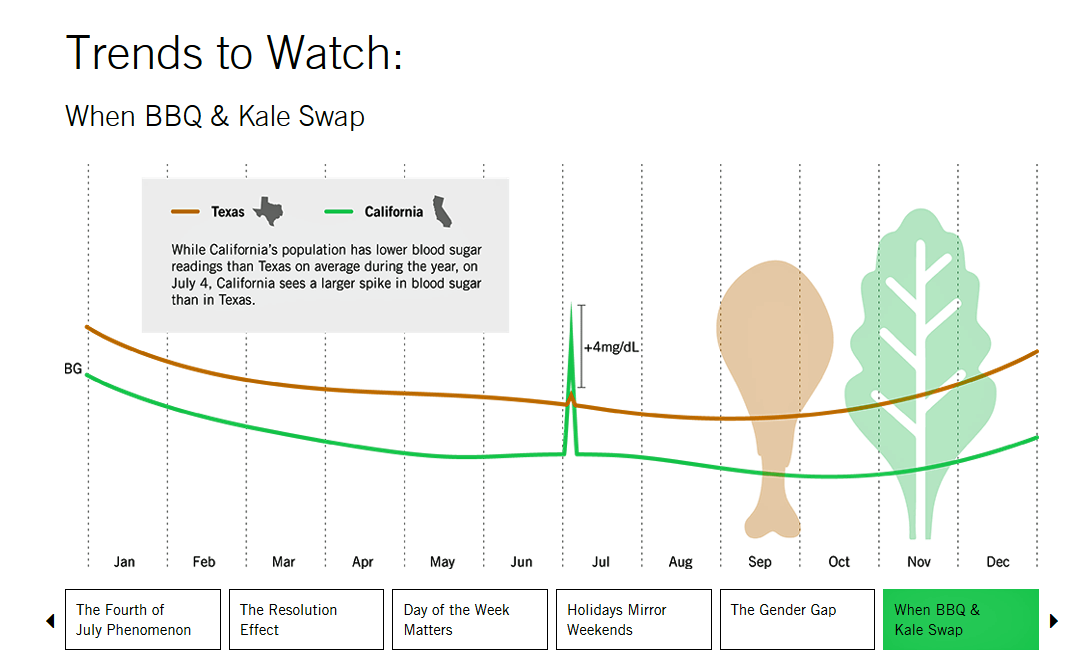
In the USA, July 4th celebrates the adoption of the Declaration of Independence on that day in 1776.
For people with diabetes, July 4th is also an inflection point when blood glucose spikes and kicks off a rise in blood sugar levels through autumn to New Year’s Eve.
The team at Livongo observed this by mining 20 million blood glucose measures among its community of people with diabetes. This research debuted in the inaugural Insights Report, Diabetes Across America: Seasons, Regions & More.
I appreciated the opportunity to discuss these findings with Dr. Jennifer Schneider, Chief Medical Officer at Livongo.
I kicked off our conversation noting that most people make personal health care resolutions on January 1st, and most fall off those well-intentioned wagons by Easter-time when chocolate marshmallow bunnies and honey baked ham beckon us to the holiday table. When you examine the first graph, you see that Livongo’s health citizens well-manage blood glucose all the way to July.
Thus, I asked, “are people with diabetes more disciplined than other folks?”
Dr. Schneider’s experience has shown her that people with diabetes (PwD) have to constantly think about their condition. “A donut isn’t healthy,” she explained, but with diabetes, people have to change their medication and ask what eating that donut will mean for the rest of the day.
PwDs confront what Dr. Schneider called an “extra layer of nutritional decisions” compared with people who don’t deal with diabetes.
“Most people with diabetes can more accurately tell you the grams of carbs in any food or food group,” she explained. “With diabetes, you are thinking about how quickly sugar gets into the system.”
To me, that means PwDs are more mindful about these multiple nutrition decisions each day.
So, then, “What is it about 4th of July?” I wondered.
 When holidays happen, Dr. Schneider explained, “the rails on the bus get wobbly.” She pointed out that before July, there aren’t that many holidays that can de-rail people from our best health objectives. But once July 4th occurs, there’s a succession of holidays that happen in the latter half of the year at a rapid pace: back-to-school celebrations, then Halloween, followed by Thanksgiving, Christmas, and New Year’s Eve and Day.
When holidays happen, Dr. Schneider explained, “the rails on the bus get wobbly.” She pointed out that before July, there aren’t that many holidays that can de-rail people from our best health objectives. But once July 4th occurs, there’s a succession of holidays that happen in the latter half of the year at a rapid pace: back-to-school celebrations, then Halloween, followed by Thanksgiving, Christmas, and New Year’s Eve and Day.
The 4th of July, then, is the first holiday “spike,” followed by the many holidays that mirror weekends — when people, us frail humans all, tend to let our nutrition-and-exercise guards down a bit.
There’s another intriguing finding, shown in the second chart, “When BBQ & Kale Swap.” This chart illustrates California Livongo members (graphed in green) compared with those living in Texas (graphed in brown). See that PwDs who live in California have uniformly lower blood glucose rates than people living in Texas. However, on the 4th of July, Californians “swap kale” for barbeque — that is, their glucose spikes probably as part of the July 4th holiday effect.
Here’s a case where, while all healthcare is local, on holidays, we’re all human.
This is the first in a series Insights Reports to come from Livongo, examining their rich trove of data for people with diabetes.
 Health Populi’s Hot Points: The Livongo research demonstrates the power of data in healthcare to illustrate the patient story beyond medicine — the human side of living with a chronic condition like the 30 million Americans with diabetes. The condition demands people/patients to be mindful every day, and throughout that day. We live lives beyond our diagnoses: we’re parents, we’re kids, we’re workers, we’re community members, we’re in faith-based communities, we volunteer, we live, work, play, pray and learn.
Health Populi’s Hot Points: The Livongo research demonstrates the power of data in healthcare to illustrate the patient story beyond medicine — the human side of living with a chronic condition like the 30 million Americans with diabetes. The condition demands people/patients to be mindful every day, and throughout that day. We live lives beyond our diagnoses: we’re parents, we’re kids, we’re workers, we’re community members, we’re in faith-based communities, we volunteer, we live, work, play, pray and learn.
That’s where those social determinants of health come in well beyond our genetic codes. Healthcare happens in life’s moments, the large and the small, on Sundays through Saturdays. And on holidays, we want to be part of celebrations with the people we love.
We are also payors of healthcare these days. If we are dealing with diabetes, then we face increasing costs for expensive insulin, benefit from frequent check-ins with the healthcare system, and need access to opportunities for physical exercise and activity and nutritious food. People diagnosed with diabetes have average medical spending of $16,752 per year, $9,600 of which is directly attributable to diabetes. In total, this spend is about 2.3 times greater than what healthcare costs would be without diabetes. These costs go well beyond the wallet.
If you get out of bed on the 4th of July, feel blessed to be alive in America. Remember what those sage authors of the Declaration of Independence told us:
We hold these truths to be self-evident, that all men are created equal, that they are endowed by their Creator with certain unalienable Rights, that among these are Life, Liberty and the pursuit of Happiness.
Let us be mindful that Americans, regardless of medical condition, are all created equal. Let us confront and address health disparities where they exist, and overcome discrimination of people regardless of their health status. That is at the heart of the brilliant document imagined by Thomas Jefferson, John Adams, and Benjamin Franklin (shown here in Writing the Declaration of Independence 1776, painted by Jean Leon Gerome Ferris in 1900).
In meditating on these words that too many of us take for granted, I hearken back to Franklin’s statement that “you [that is, ‘We’] have a Republic….if you can keep it.”
Happy, Healthy Holiday to All…
The post Diabetes and Independence Day: An Inflection Point for Rising Blood Sugar appeared first on HealthPopuli.com.
Diabetes and Independence Day: An Inflection Point for Rising Blood Sugar posted first on http://drugsscreeningpage.blogspot.com/
No comments:
Post a Comment